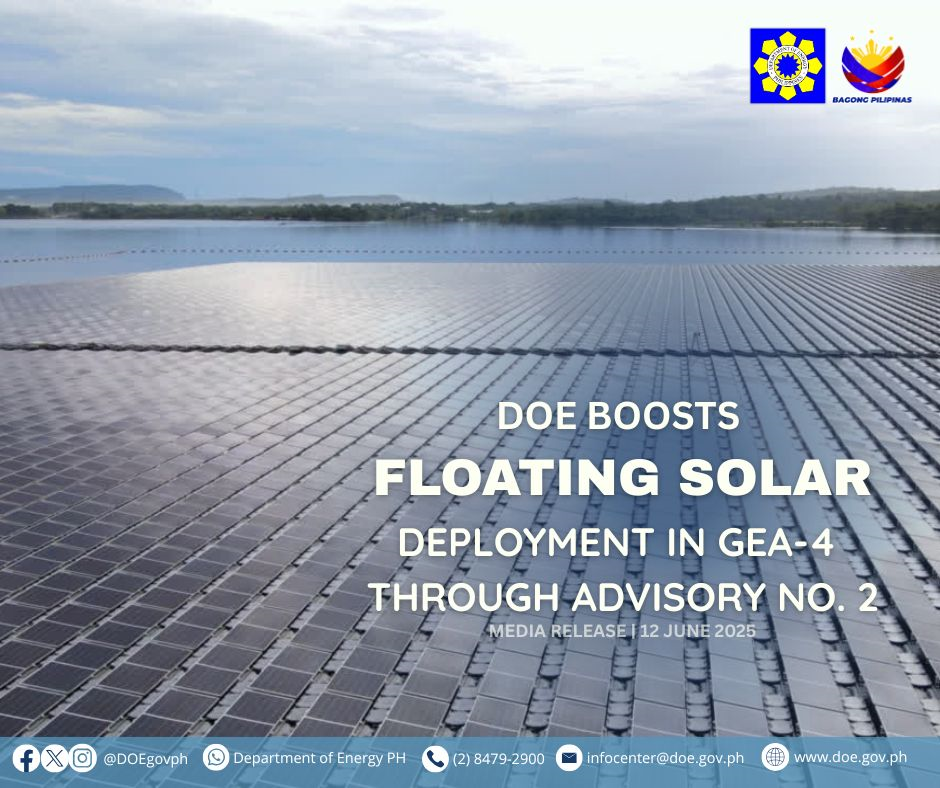The Department of Energy (DOE) has reaffirmed its commitment to innovation and renewable energy advancement through the issuance of Advisory No. 2, which introduces major enhancements supporting Floating Solar technology, under the Fourth Round of the Green Energy Auction (GEA-4).
Floating Solar, an emerging clean energy solution that utilizes bodies of water such as lakes, reservoirs, and dams for solar panel installations, offers a unique opportunity to maximize land use efficiency, reduce water evaporation, and improve panel performance through natural cooling.
Key Highlights of Advisory No. 2 on Floating Solar:
Strategic Reallocation of Capacity. The DOE has reallocated the 1,040MW installation target capacity previously scheduled under Luzon for 2026, distributing it across 2027, 2028, and 2029. This move is designed to provide developers with greater preparation time, improve project feasibility, and support grid readiness for this specialized technology.
Additional Capacity in Visayas. Recognizing regional demand and investor interest, the DOE has also approved an additional 175MW capacity for Floating Solar in the Visayas, scheduled for auction in 2027 and 2028. This expansion opens new avenues for project development across the archipelago, particularly in areas with limited available land.
These measures mark a historic push toward integrating Floating Solar into the country’s mainstream renewable energy mix. By proactively adjusting timelines and capacity allocations, the DOE is signaling strong institutional support for innovative RE solutions, while creating space for broader participation among developers and investors.
Prior to Advisory No. 2, the DOE has also released Advisory No. 1 on 28 May 2025, which introduces key procedural and technical enhancements across the broader GEA-4 framework:
- Standardization of Solar Capacity Units: Solar capacities must now be expressed in MWAC (Pmax) to represent the maximum stable load output, replacing the previous MWp unit.
- Expanded Bidding Flexibility: Solar developers will be allowed to bid either stand-alone solar or integrated solar + Energy Storage Systems (ESS), regardless of their initial development scheme. This is contingent on timely notice, submission of separate bid bonds, and possession of a valid RE Contract or Certificate of Authority.
- Administrative Enhancements: The DOE clarified that ESS capacity is not required at the time of registration, and that user-specific bidder IDs will be issued upon confirmation of project lot preferences.
- Post-Award Compliance Requirements: Winning bidders must submit detailed project designs that reflect the awarded scheme. For Solar + ESS projects, a new System Impact Study or Distribution Impact Study is required.
- Bid Bond Calculations: Bid bonds will be computed solely based on the MWAC of the solar component, ensuring financial clarity.
- Additionally, updated Instructions to Bidders and a revised GEA-4 Registration Form were issued as Annexes C and D.1, respectively, to streamline the registration process.
These comprehensive updates underscore the DOE’s mission to deliver a transparent, competitive, and future-forward renewable energy auction system. As the Philippines targets 35% renewable energy share by 2030, the rollout of technologies like Floating Solar will play a transformative role in achieving a cleaner, more resilient energy future for all Filipinos. ###

